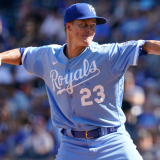On Monday, the Boston Red Sox introduced former Tampa Bay Rays executive Chaim Bloom as their chief baseball officer. Bloom is, of course, succeeding former team president Dave Dombrowski, who around this time last year was lifting the World Series trophy. The Red Sox fired Dombrowski in September, kicking off what's likely to be a hectic offseason full of changes.
As part of Bloom's media session, he emphasized the concept of "long-term sustainability." What that means varies by person and interpretation. The generous read is that Bloom wants to turn the Red Sox into an annual contender -- as is the goal for every decision maker running every team. Dombrowski succeeded in that goal. The Red Sox haven't had a losing season since 2015, and have averaged 94-plus wins in the interim four years. But, obviously, that wasn't enough for Dombrowski to remain employed, suggesting there's a different meaning in play.
What Bloom likely means when he says long-term sustainability, then, has more to do with the financial aspect. The Red Sox -- and one presumes specifically ownership -- want to spend less money. Boston has entered each of the past two seasons with payrolls exceeding $230 million, and has spent at least $180 million per season dating back to 2015. That spending more has dovetailed with great on-the-field success has been judged as correlation but not causation.
Instead, what seems to matter the most for the Red Sox is spending fewer coins and getting underneath the luxury tax number -- remember, a top team official has already conceded that keeping both Mookie Betts and J.D. Martinez will be difficult. Come this winter, the Red Sox will have paid the luxury tax in four of five years, and while the penalties are trifling in nature -- Boston paid less than $12 million last offseason -- it stands to reason one of Bloom's top tasks will be slicing and dicing payroll until the team can duck underneath the $208 million tax line.
Indeed, that process was underway before Bloom even got the job. According to league sources, the Red Sox have already been gauging other teams' interest in their players. That could be taken as standard operating procedure, expect all signs point to the Red Sox undergoing a transformation this winter. Heck, even the hiring of Bloom hints that in more ways than one. Bloom is, after all, accustomed to trying to ball on a budget in St. Petersburg. "Trying" being the key. The results weren't always impressive -- the Rays have averaged 83 wins since Andrew Friedman departed and Bloom moved up the ladder -- but they were cost effective.
Whether anyone likes it or not -- and to be clear, having one of the most lucrative teams in pro sports entertain trading a homegrown MVP candidate to avoid a trifling penalty seems like a corrosive issue for the sport as a whole -- this is the reality of the situation. As such, it's important to get a feel for what, exactly, the Red Sox might have to entertain doing.
Heading into the winter, the Red Sox's 40-man luxury-tax number is about $57 million short of the line, according to Cot's Contracts. (Remember, these are calculated based on average annual value, not year-to-year salaries.) That figure doesn't include arbitration raises to a number of key players: the aforementioned Betts, Andrew Benintendi, Jackie Bradley Jr. (a likely non-tender or trade candidate), Eduardo Rodriguez, Matt Barnes, Brandon Workman and so on.
According to MLB Trade Rumors, the combination of Betts, Benintendi, Rodriguez, Barnes and Workman is projected to make nearly $49 million next season -- or, in other words, eating up almost all of the Red Sox's luxury-tax breathing room. And that's without any external additions. Keep in mind, most teams like to keep around $10 million available for in-season acquisitions -- the hard line Red Sox would be well under that figure entering the winter. Boston's situation could be aided by Martinez opting out of his contract, thereby saving them $22 million. But even then, the Red Sox would require a new DH, at least one new veteran starter, an outfielder, a first baseman, and other bits and pieces -- all with less than $30 million to spend.
Outside of Betts, the Red Sox have six players with tax hits greater than $10 million: David Price ($31 million), Chris Sale ($25.6 million), Martinez ($22 million), Xander Bogaerts ($20 million), Nathan Eovaldi ($17 million) and Dustin Pedroia ($13.75 million). If Bloom's task is to both get under the tax line and compete in 2020, then he's going to have his hands full this winter -- especially given the rest of the league's reluctance to take on money and yield prospects.
Hence speculation about Betts' availability. He's one of the game's top players, and one of the few Red Sox that another team would be willing to do both to get. Bogaerts might be the only other player of the bunch that can be said about. Otherwise, Sale is an unknown due to his health -- though he was still an above-average starter with strong peripherals even in a down year, suggesting Boston shouldn't sell low -- and the rest have warts that will prevent them from being traded in exchange for their full value.
The best-case scenario for Boston fans is that Martinez opts out and the Red Sox are able to trade Price to a contender seeking rotation help. That would free up more than $50 million in tax savings and would permit the Red Sox to keep Betts and Bogaerts while adding to the roster -- albeit not in extravagant, top-of-the-market way, mind you.
However the winter plays out, Bloom will have a lot to juggle in his first winter at the helm. That isn't to say anyone should feel sorry for him (even a hardline Red Sox team will spend far more than the Rays teams he was part of did, and odds are Boston will exceed the luxury tax again down the road) but that everyone should understand what he really means when he talks about long-term sustainability -- and how it isn't just about wins and losses.






















